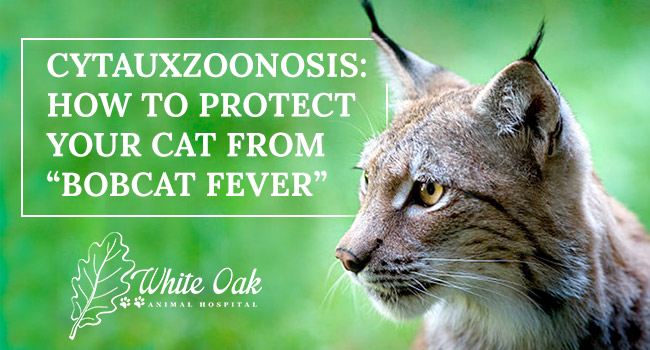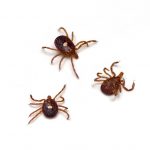
Could Your Cat Get Cytauxzoonosis or Bobcat Fever?
Unfortunately, the chances of your cat getting Cytauxzoonosis or bobcat fever are greater than you’d guess.
Here’s why.
First, let’s talk about ticks.
I think we’re long overdue a shout out to the blood-sucking, creepy, crawly arthropods we call “ticks”.
Let’s give a cheer for all they do for us!
………….*CRICKETS CHIRP*…………
My thoughts exactly.
Folks, I’ll admit I haven’t dug into the life and true purpose of these gross little pest, but my conclusion is they are truly good for nothing. Especially in the veterinary world. Besides being gross, itchy and blood-sucking, ticks are a vector for many diseases. Some of which are fatal and/or very life-threatening to our pets.
Today, we’re going to discuss one of these fatal diseases most commonly known as “Cytauxzoonosis” (often shortened to “cytaux”) or “bobcat fever”. I chose this disease to write about first because it’s a doozy. And by doozy, I mean by the time you realize something may be wrong with your kitty, it’s usually too late.
Prevention. Is. Key. Let me explain…
The Basics of Cytauxzoonosis
Caused by a protozoan parasite called Cytauxzoon felis, “bobcat fever” was first discovered in Missouri in the 1970s. Since then, it has rapidly spread to all the southern states.
The natural host for this parasite is the bobcat. Cases in other large breed cats, such as lions and cougars, have been reported. However, after further research, bobcats and domestic cats were the only species confirmed to be susceptible (likely infected). Transmission occurs when a tick bites a bobcat infected with the parasite and that same tick later bites a domestic cat.
Studies have also shown that specifically the Lone Star tick is an essential component to the disease. The disease cannot be transmitted without going through the tick first. Cat to cat transmission has been debunked through research as well.
How Bobcat Fever Works…For the Nerds Like Me!
For those of you ready to take a trip back to high school biology class, here’s what the disease does to the body.
After the infected tick bites the domestic house cat, sporozoites (immature stage of a parasite) enter white blood cells (WBCs) and replicate asexually within the body. The WBCs increase by 15x their normal size. Essentially, blood clots are formed which results in loss of blood to major organs and death of tissue. This is the main cause of death.
As if that’s not enough, the WBCs eventually rupture and then disease spreads to the red blood cells (RBCs). Fever and decrease in WBCs is a result of the RBCs becoming infected. Body temperatures can reach up to 106°F.
Cytauxzoonosis Symptoms, Or the Lack Thereof
Other than the fatality rates, one of the most unfortunate things about bobcat fever is the lack of indication of disease. Symptoms usually appear between 5-14 days (usually around day 10) after infection.
Unfortunately, the symptoms are very non-specific. Early symptoms can include depression, lethargy and anorexia (which are symptoms for 100+ other sicknesses). Upon examination, fever and dehydration are often noted.
Later symptoms can include icterus (yellow mucous membranes), enlarged lymph nodes, and an enlarged spleen and/or liver. Hypothermia, breathing difficulties and crying out in pain are some of the much later symptoms, usually seen prior to death.
Without treatment, death usually occurs 2-3 days after peak of fever.
Diagnosis and Treatment
When bobcat fever was first discovered, the fatality rate was close to 100%. However, with much research and the powers of modern medicine, that number has dropped to 64%.
There are several different drug combinations that can be used, and some have shown to have better success than others. Supportive care, such as IV fluids and hospitalization, are usually required. Oxygen therapy and blood transfusions may be required in a more progressed case.
Unfortunately, there is no good, timely diagnostic test for Cytauxzoonosis. It is possible to see the parasites on the red blood cells under a microscope via a blood smear. However, these parasites only become apparent on the RBCs 1-3 days prior to death. By then, it is usually too late.
Due to the lack of good diagnostics, we usually treat our patients upon clinical signs and suspicion of the disease.
Prevention
Applying flea/tick preventative on a regular basis is the only defense against this brutal disease. Bringing outside kitties indoors is also an effective way to control the likelihood, but we realize not all cats are made to be indoors.
Cats living in rural, wooded areas where ticks are prevalent are at greater risk. But, it’s important to realize, ticks can be ANYWHERE. Especially in sweet ole’ Tennessee where we have our city-fied ticks and your country-fried ones too.
I have clients tell/ask me all the time about using flea prevention in the winter months. Nine times out of ten, it is due to being conservative with funds. We understand that, really. Nevertheless, we live in the South and in the South, ticks don’t go away completely. It doesn’t get cold enough!
Also, it only takes ONE tick infected with the disease to bite and infect your cat. So, how can you be sure flea/tick preventative is applied before that happens? You simply can’t. Is applying tick prevention 100%? Absolutely not. (Nothing is 100% in life!) But, the odds are in your kitty’s favor by using it regularly!
Prevention. Is. Key.
Related Posts
-
The Best Way to Get Rid of Cat Allergies Naturally
Would You Like to Know How to Get Rid of Cat Allergies Naturally? Like people,…
-
When Should I Spay or Neuter My Pet?
Should I Spay or Neuter My Pet? For many years, veterinarians recommended clients spay or…
-
The $600 Hairball (And How to Prevent It): How to Treat Hairballs in Cats
Why Learn How to Treat Hairballs in Cats? If you own cats, you’ve probably dealt…
-
Feline House Soiling and What You Can Do
Behavior problems, house soiling especially, can be one of the most frustrating topics to deal…









